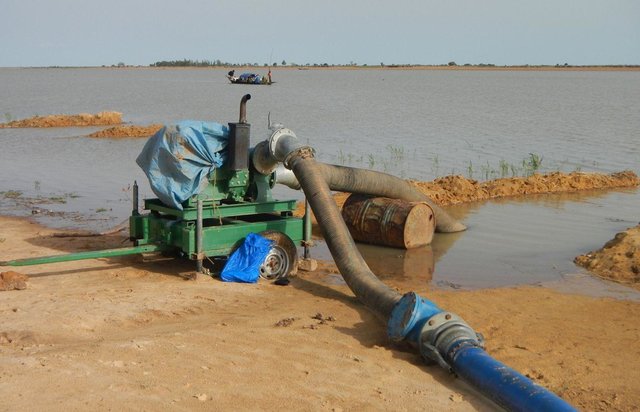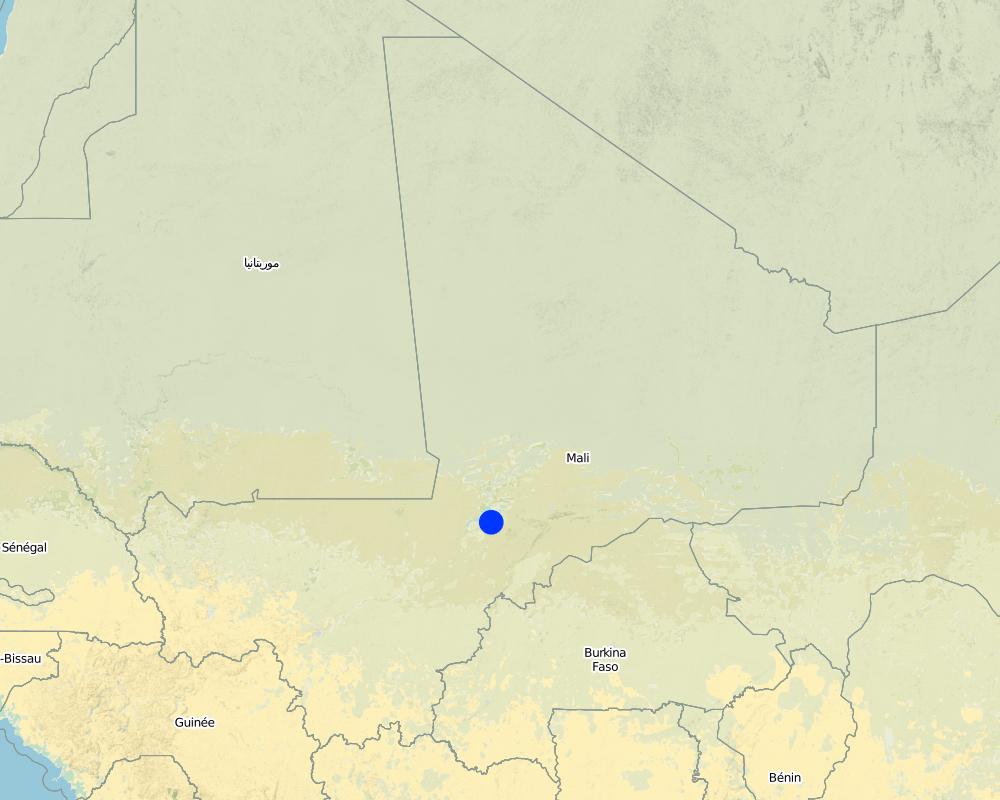Participatory approach to small-scale irrigation [ប្រទេសម៉ាលី]
- ការបង្កើត៖
- បច្ចុប្បន្នភាព
- អ្នកចងក្រង៖ Dieter Nill
- អ្នកកែសម្រួល៖ –
- អ្នកត្រួតពិនិត្យ Laura Ebneter
Approche participative dans l’irrigation de proximité
approaches_2513 - ប្រទេសម៉ាលី
ពិនិត្យមើលគ្រប់ផ្នែក
ពង្រីកមើលទាំងអស់ បង្រួមទាំងអស់1. ព័ត៌មានទូទៅ
1.2 ព័ត៌មានលម្អិតពីបុគ្គលសំខាន់ៗ និងស្ថាប័នដែលចូលរួមក្នុងការវាយតម្លៃ និងចងក្រងឯកសារនៃវិធីសាស្ត្រផ្សព្វផ្សាយ
អ្នកជំនាញឯកទេស SLM:
Kone Mamadou Gallo
gallokone@yahoo.fr
IPRO-DB Bélédougou
ប្រទេសម៉ាលី
អ្នកជំនាញឯកទេស SLM:
Schneider Ralf
ralf_schneider5@hotmail.com
IPRO-DB Bélédougou
ប្រទេសម៉ាលី
អ្នកជំនាញឯកទេស SLM:
Ouologuem Abass
ouologuemabass@yahoo.fr
IPRO-DB Bélédougou
ប្រទេសម៉ាលី
ឈ្មោះគម្រោងដែលបានចងក្រងឯកសារ/ វាយតម្លៃលើវិធីសាស្ត្រផ្សព្វផ្សាយ (បើទាក់ទង)
Le Projet Irrigation de Proximité au Pays Dogon et dans le Bélédougou, Mali (IPRO-DB)ឈ្មោះអង្គភាពមួយ (ច្រើន) ដែលបានចងក្រងឯកសារ/ វាយតម្លៃលើវិធីសាស្ត្រផ្សព្វផ្សាយ (បើទាក់ទង)
Deutsche Gesellschaft für Internationale Zusammenarbeit (GIZ) - ប្រទេសអាល្លឺម៉ង់1.3 លក្ខខណ្ឌទាក់ទងទៅនឹងការប្រើប្រាស់ទិន្នន័យដែលបានចងក្រងតាមរយៈវ៉ូខេត
តើពេលណាដែលទិន្នន័យបានចងក្រង (នៅទីវាល)?
01/07/2012
អ្នកចងក្រង និង(បុគ្គលសំខាន់ៗ)យល់ព្រមទទួលយកនូវលក្ខខណ្ឌនានាទាក់ទងទៅនឹងការប្រើប្រាស់ទិន្នន័យដែលបានចងក្រងតាមរយៈ វ៉ូខេត:
បាទ/ចា៎
1.4 ការយោងមួយ (ច្រើន) ទៅលើ (កម្រង) បញ្ជីសំណួរនៃបច្ចេកទេស SLM

Irrigation using a Californian network [ប្រទេសម៉ាលី]
A micro-irrigation system to use water more efficiently and increase yields
- អ្នកចងក្រង៖ Dieter Nill

Village irrigation schemes developed using the PMN/IPRODI approach [ប្រទេសម៉ាលី]
Village irrigation schemes (VISs) help to control the water supply and significantly increase yields.
- អ្នកចងក្រង៖ Dieter Nill
2. ការពណ៌នាអំពីវិធីសាស្ត្រផ្សព្វផ្សាយ SLM
2.1 ពណ៌នាសង្ខេបខ្លីពីវិធីសាស្ត្រផ្សព្វផ្សាយ
The participatory approach to small-scale irrigation ensures skills and expertise are transferred to scheme beneficiaries and other stakeholders.
2.2 ពណ៌នាលម្អិតពិវិធីសាស្ត្រផ្សព្វផ្សាយ
ពណ៌នាលម្អិតពិវិធីសាស្ត្រផ្សព្វផ្សាយ:
The participatory approach to small-scale irrigation (SI) ensures skills and expertise are transferred to scheme beneficiaries and other stakeholders. This enhances the value of investments and the sustainability of installations.
Direct beneficiaries (villagers) and indirect beneficiaries (technical services, communes) are involved before, during and after the installation of irrigation systems in order to ensure the sustainability of the schemes and a long-term return on investment.
Firstly, all the actors involved in the schemes are identified. Beneficiaries’ concerns are taken into account and the participation of relevant actors is ensured throughout the process. The following factors are essential when applying this approach: 1) the commitment of beneficiaries to engage in the project approach; 2) an explicit request made by beneficiaries for the scheme in question; 3) an agreement to relay the content of meetings to all beneficiaries; 4) an awareness of potentially significant constraints such as property issues, a lack of villagers available to provide labour, and the payment of financial contributions.
The participatory approach enhances the sustainability of investments, while the cost of participation remains low. The prevention and management of conflicts, the commitment of beneficiaries to schemes and the uptake of construction and management techniques by beneficiaries are all factors that contribute to sustainability.
The support structure (IPRO-DB) offers assistance in identifying the actors to involve, organises meetings, monitors information events for villagers (known as restitution sessions) and provides financial support. The village committee participates in all meetings, keeps villages informed, acts as an intermediary between associations, support structures and the community, and organises meetings. Farmers’ associations constitute sources of information, identify needs, draw up bylaws, contribute labour and funds to activities and participate in decision-making in village councils. Technical services provide advisory support and constitute sources of information. The commune provides information, raises the awareness of the actors involved, invites beneficiaries to the exchange meetings, identifies the actors involved and approves villagers’ requests.
The approach was implemented in eight villages with a combined population of around 9,240 people. The schemes cover a total area of around 766 hectares of farmland. Duration of application: Since 2005.
2.5 ប្រទេស/តំបន់/ទីតាំងកន្លែង ដែលវិធីសាស្ត្រផ្សព្វផ្សាយត្រូវបានអនុវត្តន៍
ប្រទេស:
ប្រទេសម៉ាលី
តំបន់/រដ្ឋ/ខេត្ត:
Mali
បញ្ជាក់បន្ថែមពីលក្ខណៈនៃទីតាំង:
Kambila, Nonkon, Nossombougou, N’Tjiba, Kolokani, Tioribougou
Map
×2.6 កាលបរិច្ឆេទនៃការចាប់ផ្តើម និងបញ្ចប់នៃវិធីសាស្រ្តផ្សព្វផ្សាយនេះ
សូមបញ្ជាក់ឆ្នាំដែលបានបង្កើតឡើង:
2005
2.7 ប្រភេទនៃវិធីសាស្ត្រផ្សព្វផ្សាយ
- ផ្អែកលើគម្រោង/កម្មវិធី
2.8 គោលបំណង/ទិសដៅសំខាន់នៃវិធីសាស្ត្រផ្សព្វផ្សាយ
The participatory approach to small-scale irrigation (SI) ensures skills and expertise are transferred to scheme beneficiaries and other stakeholders. This enhances the value of investments and the sustainability of installations. Direct beneficiaries (villagers) and indirect beneficiaries (technical services, communes) are involved before, during and after the installation of irrigation systems in order to ensure the sustainability of the schemes and a long-term return on investment.
The SLM Approach addressed the following problems: lack of skills and expertise, lack of involvement of beneficiaries before, during and after the installation of irrigation systems
2.9 លក្ខខណ្ឌអនុញ្ញាត ឬរារាំងការអនុវត្តន៍បច្ចេកទេសដែលស្ថិតនៅក្រោមវិធីសាស្រ្តផ្សព្វផ្សាយ
បរិបទនៃស្ថាប័ន
- រារាំង
lack of involvement of beneficiaries
Treatment through the SLM Approach: Direct beneficiaries (villagers) and indirect beneficiaries (technical services, communes) are involved before, during and after the installation of irrigation systems in order to ensure the sustainability of the schemes and a long-term return on investment.
ចំណេះដឹងស្តីពី SLM និងការទទួលបានការគាំទ្រផ្នែកបច្ចេកទេស
- រារាំង
lack of skills and expertise,
Treatment through the SLM Approach: participatory approach to small-scale irrigation (SI) ensures skills and expertise are transferred to scheme beneficiaries and other stakeholders
3. ការចូលរួម និងតួនាទីរបស់ភាគីពាក់ព័ន្ធ
3.1 អ្នកពាក់ព័ន្ធដែលបានចូលរួមក្នុងវិធីសាស្ត្រផ្សព្វផ្សាយ និងតួនាទីរបស់ពួកគេ
- អ្នកប្រើប្រាស់ដីក្នុងតំបន់/សហគមន៍
- អ្នកឯកទេសគ្រប់គ្រងដីប្រកបដោយចីរភាព/ទីប្រឹក្សាបច្ចេកទេសកសិកម្ម
- អង្គការក្រៅរដ្ឋាភិបាល
- រដ្ឋាភិបាលថ្នាក់មូលដ្ឋាន
- រដ្ឋាភិបាលថ្នាក់ជាតិ (អ្នករៀបចំផែនការ អ្នកសម្រេចចិត្ត)
3.2 ការចូលរួមរបស់អ្នកប្រើប្រាស់ដីក្នុងតំបន់/ សហគមន៍ក្នុងតំបន់ក្នុងដំណាក់កាលផ្សេងគ្នានៃវិធីសាស្រ្តផ្សព្វផ្សាយ
| ការចូលរួមរបស់អ្នកប្រើប្រាស់ដីក្នុងតំបន់/សហគមន៍ក្នុងតំបន់ | សូមបញ្ជាក់នរណាត្រូវបានចូលរួម ព្រមទាំងពណ៌នាសកម្មភាពទាំងនោះ | |
|---|---|---|
| ការចាប់ផ្តើម/ការលើកទឹកចិត្ត | អសកម្ម | |
| ការរៀបចំផែនការ | អន្តរកម្ម | |
| ការអនុវត្តន៍ | អន្តរកម្ម | |
| ការត្រួតពិនិត្យ និងវាយតម្លៃ | អន្តរកម្ម | |
| Research | អសកម្ម |
3.4 ការសម្រេចចិត្តលើការជ្រើសរើសបច្ចេកទេស SLM
សូមបញ្ជាក់តើអ្នកណាជាអ្នកបានសម្រេចចិត្តក្នុងការជ្រើសរើសបច្ចេកទេសដើម្បីយកមកអនុវត្តន៍:
- អ្នកជំនាញឯកទេស SLM បន្ទាប់ពីបានប្រឹក្សាយោបល់ជាមួយអ្នកប្រើប្រាស់ដី
ចូរពន្យល់:
Decisions on the method of implementing the SLM Technology were made by mainly by SLM specialists with consultation of land users
4. ជំនួយបច្ចេកទេស ការកសាងសមត្ថភាព និងការគ្រប់គ្រងចំណេះដឹង
4.1 ការកសាងសមត្ថភាព/ បណ្តុះបណ្តាល
តើវគ្គបណ្តុះបណ្តាលបានផ្តល់ឱ្យអ្នកប្រើប្រាស់ដី/អ្នកពាក់ព័ន្ធផ្សេងៗទៀតដែរឬទេ?
បាទ/ចា៎
សូមបញ្ជាក់តើអ្នកណាត្រូវបានបណ្តុះបណ្តាល:
- អ្នកប្រើប្រាស់ដី
ទម្រង់នៃការបណ្តុះបណ្តាល:
- អនុវត្តន៍ជាមួយការងារ
- ការប្រជុំជាសាធារណៈ
- វគ្គបណ្តុះបណ្តាល
4.2 សេវាផ្តល់ប្រឹក្សាយោបល់
តើអ្នកប្រើប្រាស់ដីបានទទួលនូវសេវាផ្តល់ប្រឹក្សាដែរ ឬទេ?
បាទ/ចា៎
សូមបញ្ជាក់ប្រសិនបើសេវាកម្មប្រឹក្សាយោបល់ត្រូវបានផ្តល់ឱ្យ:
- នៅលើដីរបស់អ្នកប្រើប្រាស់ដី
ពណ៌នា/ពន្យល់:
Advisory service is quite adequate to ensure the continuation of land conservation activities
4.3 ការពង្រឹងសមត្ថភាពស្ថាប័ន (ការអភិរឌ្ឍន៍អង្គភាព)
តើស្ថាប័នទាំងអស់ត្រូវបានបង្កើតឡើង ឬពង្រឹងសមត្ថភាពតាមរយៈវិធីសាស្ត្រផ្សព្វផ្សាយដែរ ឬទេ?
- បាទ/ច៎ា ជាមធ្យម
សូមបញ្ជាក់ថាតើស្ថាប័នត្រូវបានពង្រឹង ឬបង្កើតឡើងនៅត្រឹមកម្រិតណា(ច្រើន)?
- ថ្នាក់មូលដ្ឋាន
សូមបញ្ជាក់ប្រភេទនៃការគាំទ្រ:
- ហិរញ្ញវត្ថុ
- ការកសាងសមត្ថភាព/ បណ្តុះបណ្តាល
- សម្ភារៈ
4.4 ការត្រួតពិនិត្យ និងវាយតម្លៃ
តើការត្រួតពិនិត្យ និងវាយតម្លៃគឺជាផ្នែកមួយនៃវិធីសាស្ត្រដែរឬទេ?
បាទ/ចា៎
មតិយោបល់:
technical aspects were ad hoc monitored by project staff through observations
socio-cultural aspects were ad hoc monitored by project staff through observations
no. of land users involved aspects were ad hoc monitored by project staff through observations
management of Approach aspects were ad hoc monitored by project staff, land users through observations
There were no changes in the Approach as a result of monitoring and evaluation
There were no changes in the Technology as a result of monitoring and evaluation
4.5 ការស្រាវជ្រាវ
តើការស្រាវជ្រាវ គឺជាផ្នែកមួយនៃវិធីសាស្រ្តដែរឬទេ?
បាទ/ចា៎
បញ្ជាក់ប្រធានបទ:
- សង្គមវិទ្យា
- បច្ចេកវិទ្យា
សូមផ្តល់ព័ត៌មានបន្ថែមទៀតឱ្យបានលម្អិត និងចង្អុលបង្ហាញនរណាដែលបានធ្វើការស្រាវជ្រាវ:
Research was carried out on station
5. ថវិកា និងសម្ភារៈឧបត្ថម្ភពីខាងក្រៅ
5.1 ថវិកាប្រចាំឆ្នាំសម្រាប់ផ្សព្វផ្សាយ SLM
មតិយោបល់ (ឧ. ប្រភពសំខាន់នៃមូលនិធិ/ម្ចាស់ជំនួយចំបង):
Approach costs were met by the following donors: international (IPRO-DB): 100.0%
5.2 ការគាំទ្រផ្នែកហិរញ្ញវត្ថុ / សម្ភារៈដែលបានផ្តល់ទៅឱ្យអ្នកប្រើប្រាស់ដី
តើអ្នកប្រើប្រាស់ដីបានទទួលការគាំទ្រផ្នែកហិរញ្ញវត្ថ/សម្ភារៈសម្រាប់ការអនុវត្តន៍បច្ចេកទេសដែរឬទេ:
បាទ/ចា៎
5.3 សូមបញ្ជាក់ពីធាតុចូលត្រូវបានផ្តល់បដិភាគ (រួមទាំងកម្លាំងពលកម្ម)
ប្រសិនបើកម្លាំងពលកម្មធ្វើដោយអ្នកប្រើប្រាស់ដី តើវាជាធាតុចូលដ៏សំខាន់មួយដែរ ឬទេ:
- ដោយស្ម័គ្រចិត្ត
5.4 ឥណទាន
តើឥណទានដែលបានផ្តល់នៅក្រោមវិធីសាស្ត្រផ្សព្វផ្សាយសម្រាប់សកម្មភាព SLM នេះយ៉ាងដូចម្តេច?
ទេ
6. ការវិភាគរកផលប៉ះពាល់ និងសេចក្តីសន្និដ្ឋាន
6.1 ផលប៉ះពាល់នៃវិធីសាស្ត្រផ្សព្វផ្សាយ
តើវិធីសាស្ត្រផ្សព្វផ្សាយជួយអ្នកប្រើប្រាស់ដីដើម្បីអនុវត្តន៍ និងថែទាំបច្ចេកទេស SLM?
- ទេ
- បាទ/ច៎ា បន្តិចបន្តួច
- បាទ/ច៎ា ជាមធ្យម
- បាទ/ច៎ា បានខ្លាំង
The participatory approach ensures skills and expertise are transferred to scheme beneficiaries and other stakeholders. This enhances the value of investments and the sustainability of installations.
តើវិធីសាស្ត្រផ្សព្វផ្សាយនេះផ្តល់សិទ្ធិអំណាចដល់សង្គមនិងសេដ្ឋកិច្ចដែលក្រុមមិនទទួលបានផលប្រយោជន៍?
- ទេ
- បាទ/ច៎ា បន្តិចបន្តួច
- បាទ/ច៎ា ជាមធ្យម
- បាទ/ច៎ា បានខ្លាំង
Did other land users / projects adopt the Approach?
- ទេ
- បាទ/ច៎ា បន្តិចបន្តួច
- បាទ/ច៎ា ជាមធ្យម
- បាទ/ច៎ា បានខ្លាំង
The approach was implemented in eight villages with a combined population of around 9,240 people. The schemes cover a total area of around 766 hectares of farmland. Duration of application: Since 2005
Did the Approach lead to improved livelihoods / human well-being?
- ទេ
- បាទ/ច៎ា បន្តិចបន្តួច
- បាទ/ច៎ា ជាមធ្យម
- បាទ/ច៎ា បានខ្លាំង
The participatory approach facilitates understanding among the communes and the quick delivery of schemes requested by the commune. The labour and financial contribution provided reduces the investment costs of schemes. The likelihood of possible conflicts is reduced.
Did the Approach help to alleviate poverty?
- ទេ
- បាទ/ច៎ា បន្តិចបន្តួច
- បាទ/ច៎ា ជាមធ្យម
- បាទ/ច៎ា បានខ្លាំង
6.2 ការលើកទឹកចិត្តចម្បងៗរបស់អ្នកប្រើប្រាស់ដីសម្រាប់ការអនុវត្តបច្ចេកទេស SLM
- បង្កើនផលិតកម្ម
- បង្កើនប្រាក់ចំណេញ (សមត្ថភាព) បង្កើនអត្រាចំណេញ
- ការផ្សារភ្ជាប់ទៅនឹងចលនា/គម្រោង/ក្រុម/បណ្តាញ
6.3 សកម្មភាពផ្សព្វផ្សាយដែលប្រកបដោយចីរភាព
តើអ្នកប្រើប្រាស់ដីអាចធ្វើឱ្យមានចីរភាពនូវអ្វីដែលត្រូវបានអនុវត្តន៍តាមរយៈវិធីសាស្ត្រផ្សព្វផ្សាយដែរឬទេ(ដោយពុំមានការគាំទ្រពីអ្នកខាងក្រៅ)?
- បាទ/ចា៎
6.4 ភាពខ្លាំង/ គុណសម្បត្តិនៃវិធីសាស្ត្រផ្សព្វផ្សាយ
| ភាពខ្លាំង/ គុណសម្បត្តិ/ ឱកាស ទស្សនៈរបស់បុគ្គលសំខាន់ៗ |
|---|
| The only costs incurred relate to catering and venue charges for the training workshops and study trips. The cost of participating in study trips remains very low, except in cases where there is no local village with expertise in the subject in question. |
|
The participatory approach facilitates understanding among the communes and the quick delivery of schemes requested by the commune. |
| The labour and financial contribution provided reduces the investment costs of schemes. |
| The likelihood of possible conflicts is reduced. |
| skills and expertise are transferred to scheme beneficiaries |
| enhances the value of investments and the sustainability of installations |
| Direct beneficiaries (villagers) and indirect beneficiaries (technical services, communes) are involved before, during and after the installation of irrigation systems in order to ensure the sustainability of the schemes and a long-term return on investment |
7. ឯកសារយោង និងវេបសាយ
7.1 វិធីសាស្ត្រ/ ប្រភពនៃព័ត៌មាន
- តាមការចុះទីវាល ការស្រាវជ្រាវនៅទីវាល
- ការសម្ភាសន៍ជាមួយអ្នកប្រើប្រាស់ដី
7.2 ឯកសារយោងដែលបានចេញផ្សាយ
ចំណងជើង អ្នកនិពន្ធ ឆ្នាំ ISBN:
Manual of Good Practices in Small Scale Irrigation in the Sahel. Experiences from Mali. Published by GIZ in 2014.
មានប្រភពមកពីណា? ថ្លៃដើមប៉ុន្មាន?
http://star-www.giz.de/starweb/giz/pub/servlet.starweb
ការតភ្ជាប់ និងម៉ូឌុល
ពង្រីកមើលទាំងអស់ បង្រួមទាំងអស់ការតភ្ជាប់

Irrigation using a Californian network [ប្រទេសម៉ាលី]
A micro-irrigation system to use water more efficiently and increase yields
- អ្នកចងក្រង៖ Dieter Nill

Village irrigation schemes developed using the PMN/IPRODI approach [ប្រទេសម៉ាលី]
Village irrigation schemes (VISs) help to control the water supply and significantly increase yields.
- អ្នកចងក្រង៖ Dieter Nill
ម៉ូឌុល
គ្មានម៉ូឌុល


